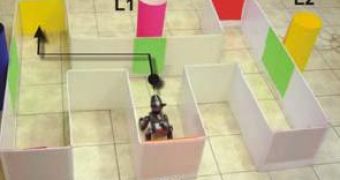A new robot using a brain similar to that of a rat, with artificial neurons, actually behaves like the real thing. This behavior is partly induced by the control software, also inspired by the actions of the real animal.
The robot was built by Alfredo Weitzenfeld, a roboticist at the ITAM technical institute in Mexico City, based on the platform borrowed from Sony's AIBO robot, the first robot dog to recognize and react to words and objects.
The scientist reprogrammed the robot rat with the rat-inspired control software, which makes it navigate towards a reward in a maze in a similar way to its biological brothers. This exploring pattern is due to artificial neurons that mimic the "place cells" found in the hippocampus, an area of the rat's brain which helps rats map their environment.
According to Weitzenfeld, the robot rat was able to recognize familiar places that it had previously visited and also to distinguish between different locations that looked similar, thus figuring out where exactly it was when it was placed in an unfamiliar part of the maze, all this after only one session.
He said that the work they are doing is unique in that they're really successful in reproducing experiments carried out using live rats, with robotic applications, thus shedding some light on how spatial problems are solved neurologically by the rat.
"Our goal is to extend our current models by testing new hypotheses in robots," he says, "and by performing corresponding new experiments with real rats that may lead to further understandings in rat spatial memory and learning."
"We believe this work will also inspire, in due time, new robotic approaches to SLAM [Simultaneous Localization and Mapping] and learning in robots," concluded Weitzenfeld. Further experiments and developments could eventually produce machines able to create their own maps of the surroundings, without human input.

 14 DAY TRIAL //
14 DAY TRIAL //